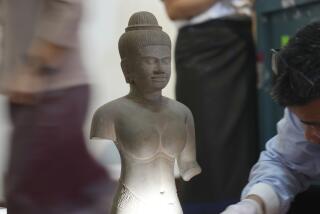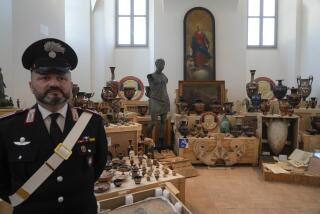Russia Displays Treasures of Art Seized in Germany
- Share via
MOSCOW — With a declared aim to “fill in blank spots in the history of culture,” Russian officials on Monday opened the first of a series of exhibitions of art treasures seized by Soviet troops from Nazi Germany at the end of World War II and hidden for 50 years.
Sixty-three paintings by European masters from the Italian Renaissance to French Impressionism--many never before viewed in public, others feared destroyed in the war--went on display at the Pushkin State Museum of Fine Arts. The show was billed as a “festival of culture” for “all people.”
But the sub-theme of the exhibition and others to follow, the first such showings of war trophy art in post-Communist Russia, is how responsibly the Russians claim to have preserved and restored some of the world’s greatest art--and how they should be entrusted to keep it.
Like plans to unveil an even richer war trove of paintings at the State Hermitage Museum in St. Petersburg next month, the Pushkin show irritated the German government, which is demanding that Moscow live up to international agreements to give the stuff back.
“For the past two years, in the spirit of our shared future in a new Europe, Russian and German experts have been striving to overcome this unhappy consequence of war by preparing for the return of cultural objects,” Otto von der Bablentz, the German ambassador to Moscow, said pointedly in remarks at an official reception marking the Pushkin show’s opening. “I trust that this exhibit of artworks, overwhelmingly from German private collections, will contribute to this goal.”
Mikhail Y. Shvydkoi, Russia’s deputy culture minister, dismissed the Germans’ concern, saying he hoped the flood of revealed art over the coming years “will be a genuine delight and joy . . . that will push all political and legal issues around these works into the background for some time.”
And Russian officials used the occasion to reveal draft legislation, being prepared for Parliament at the approach of the 50th anniversary of the Nazi defeat, that would declare paintings, tapestries, jewelry and other art taken from Nazi state institutions to be the property of Russia.
Starting in 1945, brigades of the Soviet Trophy Commission seized millions of such objects from the Nazis, who had plundered Soviet territory during the war. Crates of treasures from German museums and private collections, including those of Adolf Hitler, were brought by train to Russia and stored in secret depositories in museums such as the Pushkin and the Hermitage.
The missing treasures, a Soviet state secret for nearly half a century, have been called the last prisoners of World War II. Word of their existence began to leak out only as the Soviet Union collapsed, leading to bitter negotiations with Germany over their return.
Though art and artifact looting occurred on both sides, the defeated Germans were forced to return their booty, while the Soviets hid theirs in secret museum repositories.
The dispute over the treasures has strained relations between Russia and its biggest aid donor. Moscow contends that, despite agreements with Germany in 1990 and 1992 to return “unlawfully removed cultural property,” the seizure of German artworks was not unlawful under a new interpretation of postwar history--that the Allied Control Council running Berlin in the late 1940s indirectly endorsed the concept of art reparations from Germany.
Today, Germany claims that more than 2 million art objects were looted by the Red Army in World War II, including 200,000 paintings. While Russia has yet to make a full accounting of this art, the series of exhibitions may represent a start.
The Pushkin exhibit, for example, contains the first two works by the Spanish realist Francisco Jose de Goya ever shown publicly in Russia and three French Impressionist canvases apiece by Edgar Degas and Pierre Auguste Renoir. Also featured are such luminaries as Lucas Cranach, Honore Daumier, Edouard Manet, Tintoretto and El Greco.
Twenty-one of the works are listed from German museums, 16 from private collections and the rest from unknown collections.
Next on the calendar, March 30, comes the Hermitage show called “Hidden Treasures Revealed”--74 French paintings, many of them Impressionist masterpieces.
In the fall, the Pushkin promises to show 308 famed drawings acquired from Dutch banker Franz Koenigs in a forced sale to Hitler’s representatives. And next spring, it plans to unveil another Red Army war prize--the Trojan gold, one of the most famous finds in archeological history.
Irina Antonova, who as a young curator listed trophies as they arrived in Moscow and since 1961 has guarded their secrets as director of the Pushkin, said the 63 paintings on display Monday “are the best of what we have in store” but represent just one-sixth of the museum’s war booty.
Defending the trophy-taking as an “act of heroism,” Antonova said the paintings in the show, which runs through July 16, were “salvaged twice, once by the Soviet army and then by museum employees and restorers.”
“I have never felt guilty,” she told reporters. “On the contrary, I have prided myself on how we managed to preserve these artistic treasurers for our people.”
Rainhold Frickhinger, a German Embassy spokesman, acknowledged that the Pushkin show was a step forward in one sense: “It gives us more information. If Russia displays all works of art it has taken from Germany, then public discussion can only be enhanced.”
But he objected to the way the Pushkin had sprung the show on Germany and the world with only a few days’ warning and had restored disputed works of art without consultation. “They didn’t need to be ‘rescued,’ ” Frickhinger said after viewing the display. “Without the consent of the legitimate owner, you should not touch works of art. You also should not exhibit them.”
Other critics fault the Pushkin for displaying the art without seeking international help to identify its origins.
“It reminds me of ancient Rome when they came home from plundering and spread out the goods on the streets and nobody cared what it was or where it came from as long as it was valuable,” said Wilhelm Korte, an art sleuth and historian based in the United States.
“I can only interpret this exhibition as one of a defiant owner who sees her ownership rights challenged and says, ‘I can show you. I can put these on display any time I want.’ ”
The show is also controversial because eight of its best works, including Goya’s “Carnival” and Renoir’s “Chrysanthemums and a Japanese Fan”--came from Andras Herzog and Ferents Hatvany, Hungarian Jewish collectors who were victims, not aggressors, in the war.
More to Read
Sign up for Essential California
The most important California stories and recommendations in your inbox every morning.
You may occasionally receive promotional content from the Los Angeles Times.













